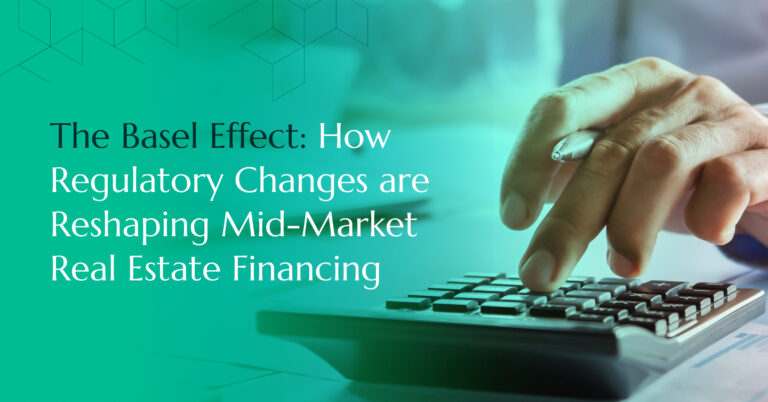Basel III regulations are reshaping the financial landscape, forcing traditional lenders to withdraw from riskier loans. This retreat has left a funding gap in mid-market real estate, but for private credit investors, this could be an open door to opportunity.
The past few years have been turbulent for real estate, with valuations declining across key European markets. But in Germany, signs of stabilisation are emerging: investment levels are picking up, and property prices are showing early signs of recovery. Could this be the turning point?
Timing the bottom of any market is risky, like trying to catch a falling knife. However, as Germany’s property sector shows resilience, it offers valuable insights into how private credit can capitalise on revalued assets. In this article, we’ll explore what Germany’s real estate reset means for investors and why now could be the moment for private credit to step in.
Germany’s real estate market: A case study in revaluation
Germany has faced significant headwinds in recent years, as have many global property markets. Rising interest rates, persistent inflation, and shifting regulatory frameworks have placed real estate under pressure. With banks tightening their lending criteria, the sector has struggled with falling demand and a prolonged valuation reset. However, change may be on the horizon.
Commercial real estate: Signs of a turning point?
A Reuters report shows Germany’s commercial property sector has been on a four-year downward trajectory, with valuations declining by 5.4% in 2024 alone. Yet, amidst this prolonged downturn, Q4 2024 posted a 0.5% increase – a seemingly minor shift but one that many see as an early sign of stabilisation. Notably, this is the first quarterly uptick since early 2022, suggesting the worst may be behind us.
Residential real estate: Uneven recovery across cities
After a decade-long price surge from 2012 to 2022, German house prices tumbled through 2022-2024. However, much like the commercial sector, the pace of decline has slowed, with certain cities now showing early signs of recovery.
- Berlin: Apartment prices fell 0.99% YoY in Q3 2024, compared to a sharp 7.23% drop in 2023.
- Hannover: Prices rose 1.06%, a major turnaround from -14.59% in 2023.
- Hamburg: A 0.49% increase, reversing some of the 7.99% loss from the previous year.
While the general trend suggests a market bottoming out, location matters. Consequently, private credit investors looking to capitalise on the reset must be highly selective in identifying the right regional opportunities.
Investor sentiment
While raw valuation data is useful, investment activity often serves as a more reliable leading indicator:
- In 2024, German real estate investment volumes surged to €34.3 billion, a 21% increase YoY.
- Q4 2024 alone saw €12.4 billion in investment, a 52% increase over Q4 2023 and a 69% quarter-on-quarter jump.
This influx of capital suggests that investors increasingly view revalued real estate as an attractive entry point.
Where is the money flowing?
In 2024, the majority real estate investment was distributed as follows:
- 25% – Multifamily Housing
- 23% – Logistics
- 18% – Retail
- 17% – Office
- 4% – Hotels
- 3% – Healthcare
The increased investment volumes and shifting asset allocations indicate that smart capital is positioning ahead of a potential recovery. While macroeconomic risks remain, improving sentiment and stabilising valuations suggest that, for private credit investors, the window of opportunity may be opening.
Private credit investors: Capitalising on the shift
At Emerald Peak, we specialise in mid-market European real estate financing, particularly in sectors where traditional lenders have withdrawn. Our deep regional expertise in Germany and Scandinavia allows us to originate high-quality transactions, leveraging our on-the-ground presence and relationships with developers and sponsors.
By combining bespoke structuring with active risk management, we provide capital solutions that balance flexibility for borrowers with strong protections for investors.
While the market appears to be entering a period of consolidation, the presence of “forced sellers” may temper short-term price recovery. So, where does this leave private credit investors?
Opportunities for private credit
Several key factors make this an attractive entry point:
- Revaluation strengthens loan security – Lower asset prices mean private credit investors can underwrite loans with better collateral coverage.
- Momentum is building – Investment volumes surged in late 2024 and are carrying into 2025, suggesting a shift in market sentiment.
- Banks offloading risky loans – Traditional lenders are becoming forced sellers, creating opportunities for private credit to step in at discounted valuations.
- Refinancing and new development openings – Stabilising property values allows for renewed lending activity, particularly in mid-market real estate projects.
- Realistic yields – The valuation reset has resulted in more sustainable real estate yields, improving the risk-adjusted return profile.
In short, private credit is filling a growing funding gap, and those positioned correctly can capitalise on attractive, asset-backed opportunities.
Risks and market considerations
Of course, challenges remain, and investors must navigate the landscape carefully:
- Subdued economic growth – The broader economy remains weak, which could limit rental growth and transaction activity.
- Geopolitical uncertainty – Ongoing global risks may impact investor sentiment and slow market recovery.
- Potential inflation pressures – The introduction of new US tariffs could fuel inflation, raise costs, and impact real estate affordability and financing conditions.
Ironically, a controlled rise in inflation could benefit property valuations and rental yield, but in today’s evolving market, investors must be selective and strategic.
Should investors be concerned about global trade wars and increased tariffs?
Rising trade tariffs are only part of the issue, with the broader concern for most investors being uncertainty. While the recovery in Germany’s real estate market is gaining momentum, escalating tariffs are weighing on global economic growth forecasts, raising the question: Will the recovery hold?
We are not suggesting that there is no downside to a slowing economy, but we believe that niche opportunities for private credit firms will always exist. Overlay this with the relative resilience of residential real estate, potential boosts in warehouse demand as companies stockpile to hedge against price rises, and “tariff hopping” by American firms seeking new premises or jurisdictions, and the opportunity set broadens further.
While a buoyant economy benefits developers and financiers alike, there will always be space for nimble private credit strategies. Should Germany’s economy stall, traditional development finance in the midmarket will likely tighten, creating a vacuum for asset-backed lending. Conversely, rising activity and financing needs will present even more openings for private credit to thrive if momentum continues.
What’s the bottom line?
This is a transitional period. Private credit investors who move early, before the market fully normalises, stand to gain from undervalued assets, better loan security, and an expanding funding gap. The key is smart capital allocation, strong due diligence, and strategic regional focus.
Is private credit the answer?
As regulatory pressures reshape the lending landscape, mid-market real estate developers are increasingly turning to private credit for flexible, long-term financing at competitive rates. While private credit remains subject to its own regulations (not Basel), it offers greater creativity in structuring deals, giving developers access to tailored solutions that traditional lenders can’t provide.
Unlike banks, which often prioritise short-term lending cycles, private credit investors can also take a longer-term view, especially when real estate assets secure loans. This ability to ride out market fluctuations makes private credit an ideal funding source in today’s evolving landscape.
The German example: Following the investment ripple effect
Germany’s real estate market appears to be stabilising, but as always, recovery won’t be uniform. Prices in major cities will likely recover first, compressing yields and pushing investors toward secondary markets in search of better value opportunities.
This ripple effect presents a prime opportunity for experienced private credit investors like Emerald Peak, who specialise in spotting emerging value trends beyond traditional core markets.
Why private credit is becoming the only real option
With traditional lenders retreating from mid-market real estate, private credit is increasingly the only viable funding source for many developers seeking scalable, asset-backed financing.
Yet, even as opportunities emerge, due diligence remains the key. Emerald Peak’s disciplined approach to asset-backed private credit – combined with rebased valuations and recalibrated risk-adjusted returns – ensures we invest in opportunities with firm structural foundations. For those who recognise the shift, private credit isn’t just an alternative; for many, it’s the future of mid-market real estate finance.
Germany’s real estate experience is not isolated; it mirrors trends playing out across multiple European markets. While rising investment volumes and price stabilisation are positive signs, the real opportunity for private credit investors lies in the rebasing of valuations from previous highs.
Private credit is already capitalising on tightened banking regulations under Basel III and IV, but Germany’s recovery is accelerating the availability of exciting opportunities. With forced sellers still present, investors with a medium to long-term horizon can access selective, asset-backed deals offering compelling risk-adjusted yields.
Let’s talk opportunities
The team at Emerald Peak would welcome a conversation if you’re looking to explore European real estate developments and emerging private credit opportunities. Get in touch to discuss how this shifting landscape can work to your advantage.



